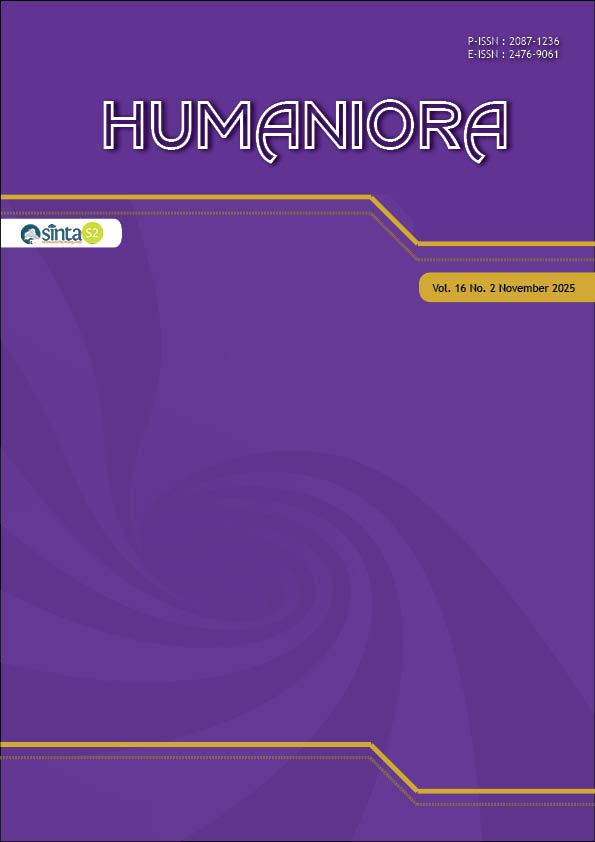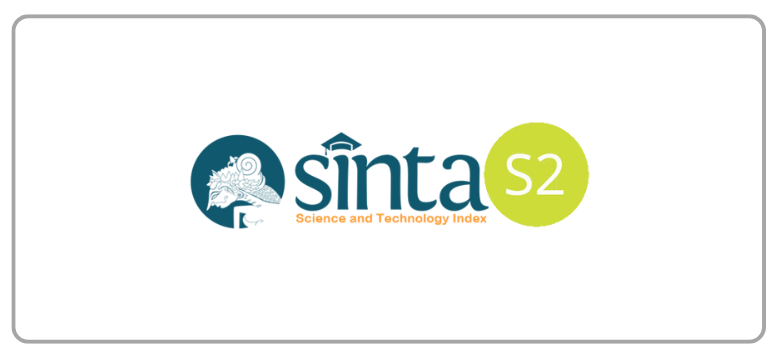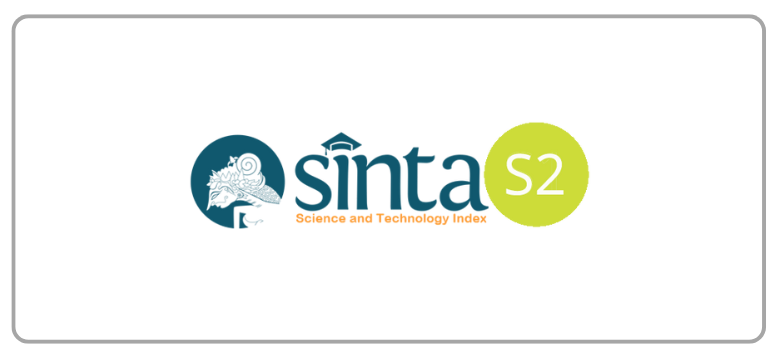The Dynamics of Javanese Culture in the Nuswantara Trilogy
DOI:
https://doi.org/10.21512/humaniora.v16i2.12907Keywords:
cultural dynamics, Javanese locality, social reality, sociology of literatureAbstract
The shifting meaning of Javanese culture is a central theme in Tunggono's Nuswantara trilogy. This topic is important to explore, as the social criticism embedded in these fictional works warrants careful analysis. This descriptive qualitative research aims to explain the role of Javanese locality as a critique of sociocultural dynamics in the trilogy. Swingewood's sociology of literature and van Peursen's theory of cultural dynamics are applied as analytical frameworks. The researcher serves as a human instrument, gathering data through heuristic reading, hermeneutic interpretation, and note-taking. The data are processed using content analysis, which includes condensation, display, conclusion drawing, and verification. The findings indicate that the Javanese cultural dynamics in the trilogy can be categorized into three domains. First, mystical thought encompasses Hindu–Kejawen practices associated with shamans, the controversial jamasan keris ritual, sajen (offerings) and dupa (incense) to summon dedemit (spirits), mystical gamelan, and the perception of spiritual knowledge as identical with supernatural science. Second, ontological thought presents social critiques that challenge mystical traditions, contending that such beliefs do not correspond to the authentic essence of Javanese locality. Third, functional thought highlights critiques that link cultural practices to their societal and practical functions, underscoring the adaptability of Javanese culture within contemporary contexts. Tunggono’s cross-cultural engagement contributes to revitalizing discourse on Javanese cultural dynamics in literature, carried out with a strong sense of intellectual responsibility. The research affirms that Javanese culture remains open to interpretation, reflection, and critical inquiry, offering rich possibilities for ongoing scholarly examination of its evolving significance.
References
Abrams, M. H. (1971). The mirror and the lamp. Oxford: Oxford University Press.
Adji, M., & Intan, T. (2020). Pemikiran kolektivitas, mistis, dan ontologis dalam upacara kematian Rambu Solok pada novel Puya ke Puya. Sawerigading Journal, 26(2), 209-221. https://doi.org/10.26499/sawer.v26i2.785
Agung, D. A. G., Nasih, A. M., Sumarmi, Idris, & Kurniawan, B. (2024). Local wisdom as a model of interfaith communication in creating religious harmony in Indonesia. Social Sciences and Humanities Open Journal, 9, 1-11. https://doi.org/10.1016/j.ssaho.2024.100827
Aldi, M., & Khairanis, R. (2025). Relevance of Nusantara philosophy in integrating religious doctrines for social harmony. SAMSARA: International Journal of Eastern Philosophy, 1(1), 12-20.
Andila, P. S., Warseno, T., Syafitri, W., & Tirta, I. G. (2022). Ethnobotanical study of Hindu society in Tabanan Bali and the conservation efforts. Proceedings of the 7th International Conference on Biological Science, 22, 590-597. https://doi.org/10.2991/absr.k.220406.085
Ashcroft, B., Griffiths, G., & Tiffin, H. (2025). Post-colonial studies: The key concepts (4th edition). London: Routledge.
Asih, P. S. H., Purwasito, A., Warto, & Pitana, T. S. (2023). Keris and discourse of Javanese identity. Proceedings of the International Seminar SEMANTIKS & PRASASTI 2023 Theme: Language in the Workplace (PRASASTI 2023), 247-255. https://doi.org/10.2991/978-2-38476-162-3_33
Astawa, I. P. P., Wimba, I. G. A., & Apsaridewi, K. I. (2025). Development of a competitive and adaptive Hindu education model in the global era by integrating local wisdom values and modern education. QALAMUNA: Jurnal Pendidikan, Sosial Dan Agama, 17(1), 13-28. https://doi.org/10.37680/qalamuna.v17i1.6312
Azizah, N. N. (2023). Muatan pendidikan karakter pada tradisi lisan Banjar “Upacara Batamat” siswa sekolah dasar di Banjarmasin. [Doctoral Dissertation, Universitas Negeri Yogyakarta].
Bugov, D. T. (2024). About the spiritual element in Lengger Banyumas. Harmonia: Journal of Arts Research and Education, 24(2), 444-457. https://doi.org/10.15294/harmonia.v24i2.7588
Damono, S. D. (2022). Sosiologi sastra. Jakarta: Gramedia Pustaka Utama.
Daryono, & Syukur, S. (2023). Empowerment of Islamic ethics and Javanese Hindu ethics in the formation of national character. Jurnal Penelitian, 20(2), 155-170. https://doi.org/10.28918/jupe.v20i2.1950
Debnath, S., Nath, M., Sarkar, A., Roy, G., Chakraborty, S. K., & Debnath, B. (2024). Phytochemical characterization of Styrax benzoin resin extract, molecular docking, ADME, and antibacterial activity study. Natural Product Research, 38(7), 1-6. https://doi.org/10.1080/14786419.2022.2132244
Dwiputra, D. F. K., & Sundawa, D. (2023). Analysis of potentials and challenges of culture-based learning in Indonesia : A systematic literature review. Jurnal Kependidikan: Jurnal Hasil Penelitian Dan Kajian Kepustakaan Di Bidang Pendidikan, Pengajaran Dan Pembelajaran, 9(1), 213-223. https://doi.org/10.33394/jk.v9i1.6556
Eagleton, T. (1996). Literary theory (2nd edition). Oxford: Blackwell.
Fajriani, S. N., & Widihastuti, R. A. (2024). Potret sosial masyarakat Jawa di era Orde Baru dalam kumpulan naskah drama “Gapit” karya Bambang Widoyo. Fon: Jurnal Pendidikan Bahasa Dan Sastra Indonesia, 20(2), 354-369. https://doi.org/10.25134/fon.v20i2.10420
Gond, A. G., & Bhutada, R. (2020). Concept of Dhoopana and its role in prevention of air born infection during Covid-19 outbreak. International Journal of Research in Pharmaceutical Sciences, 11(1), 963-966. https://doi.org/10.26452/ijrps.v11iSPL1.3279
Grønseth, A. S. (2021). Empathy and ritual practices. In The Palgrave handbook of anthropological ritual studies (pp. 205-226). https://doi.org/10.1007/978-3-030-76825-6_11
Imani, A. H., & Ropi’ah. (2021). Correlation of Panji’s lust in Wangbang Wideha manuscript with Javanese spirituality. Proceedings of the International Joint Conference on Arts and Humanities 2021 (IJCAH 2021), 618, 24-31. https://doi.org/10.2991/assehr.k.211223.005
Imron, A., Wiyono, B. B., Hadi, S., Mustiningsih, & Rochmawati. (2023). Management of students by integrating the values of local wisdom for the revitalization and reactualization of the nation’s identity to face the challenges of globalization. Proceedings of the International Conference on Educational Management and Technology, 180-187.
https://doi.org/10.2991/978-2-494069-95-4
Junaidi, Raharjo, A. B., Sahid, N., Sukanadi, I. M., Wicaksana, D. K., & Purnamasari, N. P. L. (2024). Character education model in wayang kulit for early childhood. Harmonia: Journal of Arts Research and Education, 24(2), 386-400. https://doi.org/10.15294/harmonia.v24i2.9625
Karomah, L., & Masyuri, M. (2024). Cultural resilience in the era of globalization : Maintaining heritage and local wisdom for future generations. Proceeding of International Conference on Education, Society and Humanity, 2(2), 1635-1641. https://doi.org/https://doi.org/10.37304/jikt.v14il.202
Kartika, E., & Wicaksono, H. (2024). The philosophy of ethnobotany and the transformation of Jamasan Pusaka tradition in the Pendopo of Batang District. Humaniora Journal, 36(2), 188-206. https://doi.org/https://doi.org/10.22146/jh.93978
Krissandi, A. D. S., Andayani, & Anindyarini, A. (2023). Javanese (Indonesia) indigenous education in a children’s literature novel at Vorstenlanden in 1937. Cogent Education Journal, 10(2), 1-28. https://doi.org/10.1080/2331186X.2023.2284542
Kurniawati, A., Yuniarno, E. M., Suprapto, Y. K., & Soewidiatmaka, A. N. I. (2023). Automatic note generator for Javanese Gamelan music accompaniment using deep learning. International Journal of Advances in Intelligent Informatics, 9(2), 231-248. https://doi.org/10.26555/ijain.v9i2.1031
Lilik, Ngarawula, B., & Suharnoko, D. (2024). Metri Deso (Village Cleansing) in the perspective of sociology of education. International Journal of Research in Social Science and Humanities (IJRSS), 5(12), 36–64. https://doi.org/10.47505/IJRSS.2024.12.3
Mazumdar, S., & Mazumdar, S. (2021). Ritual, place, and experience in Hindu Home-temple visitation. In The Palgrave Handbook of Anthropological Ritual Studies (pp. 229-254). https://doi.org/10.1007/978-3-030-76825-6_12
Miles, M. B., Hubberman, A. M., & Saldana, J. (2018). Qualitative data analysis: A methods sourcebook 4th edition. USA: Sage Publications.
Moleong, L. J. (2022). Metodologi penelitian kualitatif. Bandung: Remaja Rosdakarya.
Muthoharoh, I. (2022). Makna spiritual dalam perayaan Kirab 1 Suro (Keraton Kasunanan Surakarta). [Bachelor Thesis, Universitas Islam Negeri Syarif Hidayatullah].
Nisa, F. K., Sulistiono, B., Liyah, S., & Mumpuni, A. (2025). Pelestarian kearifan lokal Canang Sari sebagai persembahan dalam kegiatan ritual dan upacara adat. Jurnal Ilmiah Widya Pustaka Pendidikan, 13(1), 59-71. https://doi.org/https://jiwpp.unram.ac.id/index.php/widya/article/view/270
Nugraheni, L., Suyitno, Waluyo, H. J., & Wardani, N. E. (2022). The influence of Wayang Beber (the legend of Wasis Joyokusumo) as a character-based learning media on students’ critical thinking ability. International Journal of Instruction, 15(3), 267-290. https://doi.org/10.29333/iji.2022.15315a
Nurziana, S., & Firdaus, T. (2025). The concept of divinity in Javanese mysticism: Viewing the universe as a manifestation of God. SAMSARA: International Journal of Eastern Philosophy, 1(1), 1-11.
Parhan, M., & Dwiputra, D. F. K. (2023). A systematic literature review on local wisdom actualization in character education to face the disruption era. Journal of Innovation in Educational and Cultural Research, 4(3), 371-379. https://doi.org/10.46843/jiecr.v4i3.675
Pasaribu, W. S. B., Lubis, D., & Jailani, M. (2025). Praktik doa umat Hindu: Studi pada Kuil Shri Mariamman dan Pura Agung Raksa Buana di Kota Medan. Kamaya: Jurnal Ilmu Agama, 8(1), 170-184. https://doi.org/10.37329/kamaya.v8i1.4014
Polizzi, G., & Harrison, T. (2022). Wisdom in the digital age: A conceptual and practical framework for understanding and cultivating cyber-wisdom. Ethics and Information Technology Journal, 24(16), 1-16. https://doi.org/10.1007/s10676-022-09640-3
Rahaya, I. S., Subiyantoro, S., & Setiawan, B. (2020). Pepatah Jawa sebagai prinsip hidup masyarakat modern dalam Novel Impian Amerika Karya Kuntowijoyo. Atavisme, 23(2), 249-260. https://doi.org/10.24257/atavisme.v23i2.637.249-260
Ramadhan, I. Y. (2020). Dinamika lokalitas dan modernitas Suku Banjar dalam Novel Jendela Seribu Sungai karya Miranda Seftiana dan Avesina Soebli. [Master Thesis, Universitas Airlangga].
Retno M, L. A., & Chandra, O. H. (2024). Local wisdom represented by words in Nonik Performance Ritual in Lembu Village, Semarang Regency. ICOCAS - International Conferences on Cultural and Sustainable Development Vol. 2, 296-303. https://doi.org/https://proceedings.undip.ac.id/index.php/icocas/article/view/826
Riffaterre, M. (1978). Semiotics of poetry. Bloomington: Indiana University Press.
Saputri, P., & Yuwono, B. T. (2022). The creation of Raden Adjeng Kartini’s Putut Dhapur Keris. ARTISTIC : International Journal of Creation and Innovation, 3(1), 89-114. https://doi.org/10.33153/artistic.v3i1.4454
Sari, D. K., & Muttaqin, D. (2021). Sedulur Papat Limo Pancer as a concept of Javanese emotional intelligence. Budapest International Research and Critics Institute-Journal Humanities and Social Sciences, 4(3), 6706-6712. https://doi.org/10.33258/birci.v4i3.2488
Sayuti, S. A. (2011). Pengembangan budaya dan potensi kearifan lokal. Disampaikan dalam Seminar Nasional tentang Pengembangan Pendidikan Karakter Bangsa Berbasis Kearifan Lokal untuk Menghadapi Tantangan Global oleh Lembaga Penelitian Universitas Negeri Yogyakarta.
Setiawan, A. (2021). Praktik mistisisme Jawa dalam Novel Mantra Pejinak Ular karya Kuntowijoyo. Jurnal Satwika: Kajian Ilmu Budaya Dan Perubahan Sosial, 5(2), 337-352. https://doi.org/10.22219/satwika.v5i2.18179
Sholehah, A. R., Ramadhani, N. F., & Imani, A. F. (2024). The relevance of wayang to social sciense learning. International Journal of Geography, Social, and Multicultural Education (JGSME), 1(3), 58-66. https://doi.org/https://doi.org/10.26740/ijgsme.v1n2.p58-66
Spiller, H., & Clendinning, E. A. (2022). Focus: Gamelan music of Indonesia. London: Routledge. https://doi.org/10.4324/9781003014836
Sugiyono. (2022). Metode penelitian kuantitatif, kualitatif, dan R&D. Bandung: Alfabeta.
Sujarwiyanti, W., Sinaga, R. M., & Pargito. (2020). Preparation of Bali Hindu communities and society Hindu Java in the Implementation of Nyepi Rituals in Hanura Village Teluk Pandan District Pesawaran Regency. International Journal of Research and Innovation in Social Science (IJRISS), 4(9), 342-346. http://repository.lppm.unila.ac.id/45689/1/artikel 2.pdf
Sulistiyani, & Sunarmi, F. R. (2023). Nang Ning Nung Neng Gung’s philosophical study in the strains of Javanese Gamelan as a guide to Urip Bebrayan. Proceeding of International Conference on Arts and Humanities, 82–87.
Sumarno. (2020). Analisis isi dalam penelitian pembelajaran bahasa dan sastra. Jurnal Edukasi Lingua Sastra, 18(1), 36-55. https://doi.org/10.47637/elsa.v18i2.299
Swingewood, A. (1972). The sociology of literature. London: Paladin.
Teeuw, A. (1983). Membaca dan menilai sastra. Jakarta: Gramedia.
Teeuw, A. (2017). Sastra dan ilmu sastra. Bandung: PT Dunia Pustaka Jaya.
Thohari, A. M. (2022). Kearifan lingkungan: Tradisi masyarakat Jawa dalam upaya menghormati entitas alam. Turast: Jurnal Penelitian Dan Pengabdian, 10(1), 37-48. https://doi.org/10.15548/turast.v10i1.3966
Tunggono, V. (2015). Gerbang Nuswantara. Jakarta: Penerbit Buku Kompas.
Tunggono, V. (2018). Candi Nuswantara. Jakarta: Penerbit Buku Kompas.
Tunggono, V. (2021). Jagat Nuswantara. Jakarta: Penerbit Buku Kompas.
van Peursen, C. A. (2018). Strategi kebudayaan (terjemahan Dick Hartoko). Yogyakarta: Kanisius.
Wardhani, N. W., Arditama, E., Noe, W., & Narimo, S. (2021). Merawat mistisisme dalam tradisi Ngalap Berkah sebagai upaya menjaga tatanan sosial masyarakat di Surakarta. Jurnal Antropologi: Isu-Isu Sosial Budaya, 23(1), 93-100. https://doi.org/10.25077/jantro.v23.n1.p93-100.2021
Wasisto, M. A. (2021). Reflecting on Kejawen: Javanese esoteric teachings in Indonesian national development. Udayana Journal of Law and Culture, 5(2), 96-118. https://doi.org/10.24843/UJLC.2021.v05.i02.p01
Wellek, R., & Warren, A. (2016). Teori kesusastraan (terjemahan Melani Budianta). Jakarta: PT Gramedia.
Wibawa, A. P., Handayani, A. N., Rukantala, M. R. M., Ferdyan, M., Budi, L. A. P., Utama, A. B. P., & Dwiyanto, F. A. (2024). Decoding and preserving Indonesia’s iconic keris via a CNN-based classification. Telematics and Informatics Reports Journal, 13, 1-14. https://doi.org/10.1016/j.teler.2024.100120
Widana, I. N. M., & Wirata, I. W. (2023). Strategy of Hindu institutions in maintaining religious harmony in Hindu communities in outskirts areas. Cogent Social Sciences Journal, 9(1), 1-15.
https://doi.org/10.1080/23311886.2023.2225837
Wiyatmi. (2013). Sosiologi sastra: Teori dan kajian terhadap Sastra Indonesia. Yogyakarta: Kanwar Publisher.
Zulfikar, N., Kamalia, L., & Rismalasari, D. (2023). Makna spiritual tradisi Kliwonan dalam akulturasi budaya Islam di Jawa Tengah. Indonesian Journal of Conservation, 11(2), 78-83. https://doi.org/10.15294/ijc.v11i2.37185
Downloads
Published
How to Cite
Issue
Section
License
Copyright (c) 2025 Dewi Azizah Damaryanti, Suminto A. Sayuti

This work is licensed under a Creative Commons Attribution-ShareAlike 4.0 International License.
Authors who publish with this journal agree to the following terms:
a. Authors retain copyright and grant the journal right of first publication with the work simultaneously licensed under a Creative Commons Attribution License - Share Alike that allows others to share the work with an acknowledgment of the work's authorship and initial publication in this journal.
b. Authors are able to enter into separate, additional contractual arrangements for the non-exclusive distribution of the journal's published version of the work (e.g., post it to an institutional repository or publish it in a book), with an acknowledgment of its initial publication in this journal.
c. Authors are permitted and encouraged to post their work online (e.g., in institutional repositories or on their website) prior to and during the submission process, as it can lead to productive exchanges, as well as earlier and greater citation of published work.
USER RIGHTS
All articles published Open Access will be immediately and permanently free for everyone to read and download. We are continuously working with our author communities to select the best choice of license options, currently being defined for this journal as follows: Creative Commons Attribution-Share Alike (CC BY-SA)


















